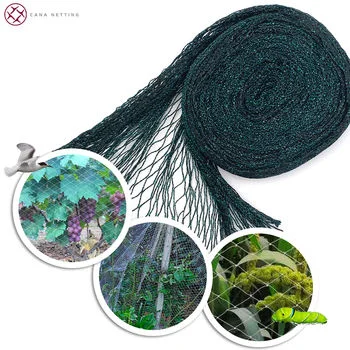Application Advantages of High Intensity Vineyard Bird Netting
In the realm of viticulture, vineyard bird netting has become an indispensable component in crop protection, particularly in regions prone to avian interference. Among the various types of bird control solutions, high intensity vineyard bird netting stands out due to its durability, efficacy, and long-term economic benefits. In this blog post, Cana Netting, as a high quality warp knitted bird screen exporter, will share the application advantages of high intensity vineyard bird netting for sale.
High Intensity Vineyard Bird Netting Application Advantages
1. Enhanced Durability and Longevity
High intensity bird netting is typically manufactured using high-density polyethylene (HDPE) or other UV-stabilized polymeric materials. These nettings are engineered to withstand harsh environmental conditions, including prolonged UV exposure, temperature extremes, wind, and mechanical stress from handling. The high tensile strength of the material ensures resistance to tearing or fraying even after repeated use over multiple growing seasons.
Unlike standard bird netting, which may degrade or become brittle after just one or two years of use, high intensity netting can reliably perform for 5 to 10 years or longer, depending on environmental factors and maintenance. This durability significantly reduces the frequency and cost of replacement, offering a higher return on investment (ROI) over the long term.
2. Superior Crop Protection
One of the core advantages of high intensity vineyard bird netting is its superior effectiveness in protecting grape clusters from avian predation. Birds such as starlings, finches, and crows are notorious for damaging ripening grapes, often causing substantial economic losses through both direct consumption and secondary spoilage from exposed fruit.
High intensity netting features tighter weave patterns and more resilient mesh structures, making it more difficult for birds to penetrate or damage the netting. Some advanced nettings incorporate micro-fiber technology that creates an almost impenetrable barrier without compromising airflow and light transmission—factors essential for healthy grape development.
3. Customizable Installation and Versatility
Modern high intensity netting systems are designed with adaptability in mind, allowing for multiple installation configurations depending on the vineyard layout, trellis system, and specific cultivar requirements. Common methods include:
- Draped Netting: Applied over the canopy and down to the ground, offering full protection for both fruit and foliage.
- Side Netting: Used when only the fruiting zone needs protection, ideal for vertical shoot positioning (VSP) systems.
- Overhead Netting: Suspended above the vineyard in a tent-like structure, particularly effective in areas with frequent bird activity.
High intensity netting is available in various widths, lengths, and mesh sizes, and can be easily tailored to different trellis systems. Many products also feature reinforced edges and color-coded markings to facilitate quick installation and removal, improving labor efficiency.

4. Environmental and Non-Lethal Deterrent
High intensity bird netting provides a humane, non-lethal method for deterring birds, aligning with environmentally sustainable farming practices. Unlike chemical repellents or auditory deterrents, which can have unintended ecological consequences or lose effectiveness over time, netting physically prevents birds from accessing the grapes without harming them.
Moreover, the use of bird netting can help reduce dependency on reactive bird control measures and minimize the vineyard’s ecological footprint. This can be a crucial factor for vineyards seeking organic certification or aiming to enhance their sustainability credentials in the market.
5. Improved Grape Quality and Reduced Post-Harvest Losses
Bird damage to grapes not only reduces the quantity of marketable fruit but also compromises quality. Pecked or broken grapes are more susceptible to fungal infections, oxidation, and pest infestations, which can spread to surrounding clusters and lead to widespread crop degradation.
By effectively shielding fruit during the critical ripening period, high intensity netting preserves the integrity and visual quality of the grape clusters. This translates to better outcomes in terms of sugar content (Brix levels), acidity balance, and overall flavor profile—factors that are vital for premium wine production.
Additionally, the reduction in damaged fruit simplifies harvest logistics, decreases the need for sorting and discarding affected grapes, and ultimately leads to a more consistent and higher-grade end product.
6. Labor Efficiency and Operational Cost Savings
Although high intensity bird netting may represent a larger upfront investment compared to standard alternatives, it offers significant labor and operational cost benefits. Due to its rugged construction and thoughtful design features such as built-in fastening loops, reinforced edges, and reusability, installation and removal processes are streamlined.
Some netting systems are compatible with mechanized application equipment, further reducing manual labor requirements and allowing for quicker deployment across larger vineyard blocks. Over time, this operational efficiency contributes to reduced labor costs and enhances overall vineyard management productivity.
7. Resistance to Tangling and Storage Benefits
Traditional lightweight netting can be prone to tangling, fraying, or knotting during handling, which adds unnecessary time and effort to installation and takedown. High intensity bird netting is typically designed to resist tangling and can be rolled or folded with ease, making off-season storage far more manageable.
Some netting types come pre-rolled or include retraction systems, allowing for quick, efficient reuse year after year. This characteristic is particularly valuable for large-scale vineyards that require consistent logistical performance across multiple seasons.
Conclusion
In summary, high intensity vineyard bird netting represents a technically superior and economically strategic solution for grape growers looking to protect their crops from bird damage. Its advantages span beyond durability and effectiveness—extending into realms of environmental responsibility, grape quality assurance, and operational efficiency. As viticulture practices continue to evolve, integrating high-performance protective measures like high intensity netting will remain a cornerstone of sustainable and profitable vineyard management.
www.cananetting.com
Cana Netting




